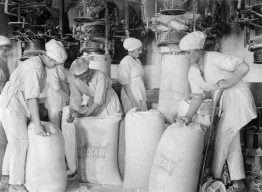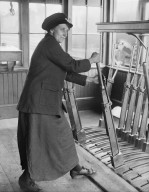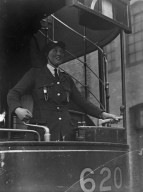By Dr Kate Murphy, Senior Lecturer in Radio Production.
In 1918, the Ministry of Information produced some striking photographs of wartime women workers: operating a railway signal box in Birmingham; cleaning shop windows in Mayfair; driving a tram in Glasgow; delivering coal in the Old Kent Road; working as clerks on the HMS Essex and moving huge flour bags at a Birkenhead flour milling factory. During the First World War, almost two million women entered paid employment for the first time, to replace men who had been called up. Crèches were set up at munitions factories while the Treasury Agreement ostensibly ensured equal pay. Women were feted as heroines, doing their bit for the war effort.

Female workers pack flour in a mill at the works of Rank and Sons, Birkenhead, Cheshire, in September 1918 © IWM (Q 28268)
While the reality might not have been so rosy – working conditions could be appalling, nurseries were few and far between, equal pay avoided by subdividing tasks – the new visibility of women in the workplace and their ability to perform tasks that had previously been deemed impossible had a profound effect on the nation’s psyche and its understanding of femininity. Women were shown to be as capable as men and married women, even mothers, combined work with family responsibilities without being denounced as aberrant.
The final year of the war saw the enactment of two significant pieces of legislation. The first was the Representation of the People Act, which enfranchised eight million women aged thirty and over (the vote was finally extended to all adult women in 1928). The second was the Parliament (Qualification of Women Act) which enabled women to stand as MP’s, ironically at age twenty-one, before they could legally vote. Nancy Astor was the first woman to take her seat in parliament, in 1919. A third piece of equal opportunities legislation was passed in 1919, the Sex Disqualification (Removal) Act (SDRA) which supposedly opened all professions to women and entitled those who were married to work.

A female railway worker operates the signals in a signal box on a siding at the Great Central Railway in Birmingham, September 1918. © IWM (Q 28148)
But despite this acceptance of new and wider roles for women, once the war had ended most were expected to give up their jobs and return to housewifery; the Treasury Agreement ended and nurseries closed. Similarly, the SDRA was circumvented by the Church and the Army while loop holes were found to enable marriage bars to be reinforced. During the ensuing years, a growing cult of motherhood and domesticity vied with women’s increasing desire for careers and fulfilment outside the home.
Feminists, whose efforts before 1914 had been concentrated on the vote, broadened their objectives to include equal pay, equal promotional opportunities and the ending of enforced spinsterhood in jobs such as teaching and the Civil Service. At the same time, divisions developed between activists who, on the one hand, believed there should be no differentiation between women and men and those, on the other, who held that women had distinctive needs that should be legislated for accordingly.
One hundred years on from the start of the First World War – how far have attitudes changed? The patronising comments that have greeted the new women members of Cameron’s cabinet, particularly the focus on their appearance and dress, would have been familiar to Nancy Astor. If their promotions are a ploy to win the next election, will these women then be discarded if the Tories have success? Likewise, the rumpus over women bishops reinforces the ever-present debate as to women’s suitability for some positions, as is also the case with Army women on the front line. Is it the deep patriarchy of these institutions which makes them so resistant to change? Or is there something inherently different about women that demands an alternative approach?
In similar vein to the years immediately after the First World War, equal pay, glass ceilings and working mothers continue to be areas of fierce argument, while images of home-making, baking and ideal mothering fill our TV screens. Women’s role and place in British society is as controversial now as it was then. In fact, those photos of women workers in 1917 look eerily post-modern and would even raise an eyebrow today.
 Bournemouth University
Bournemouth University